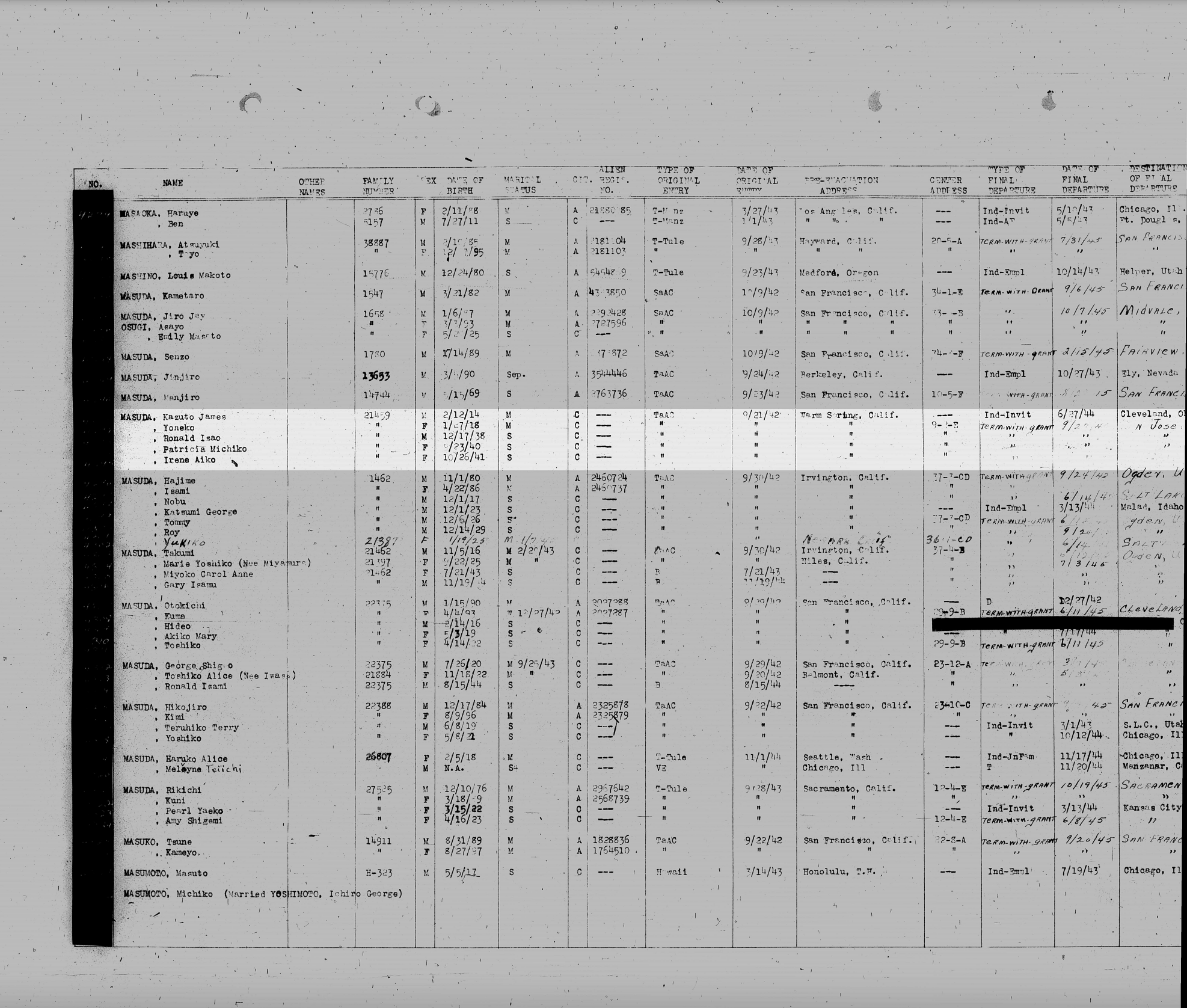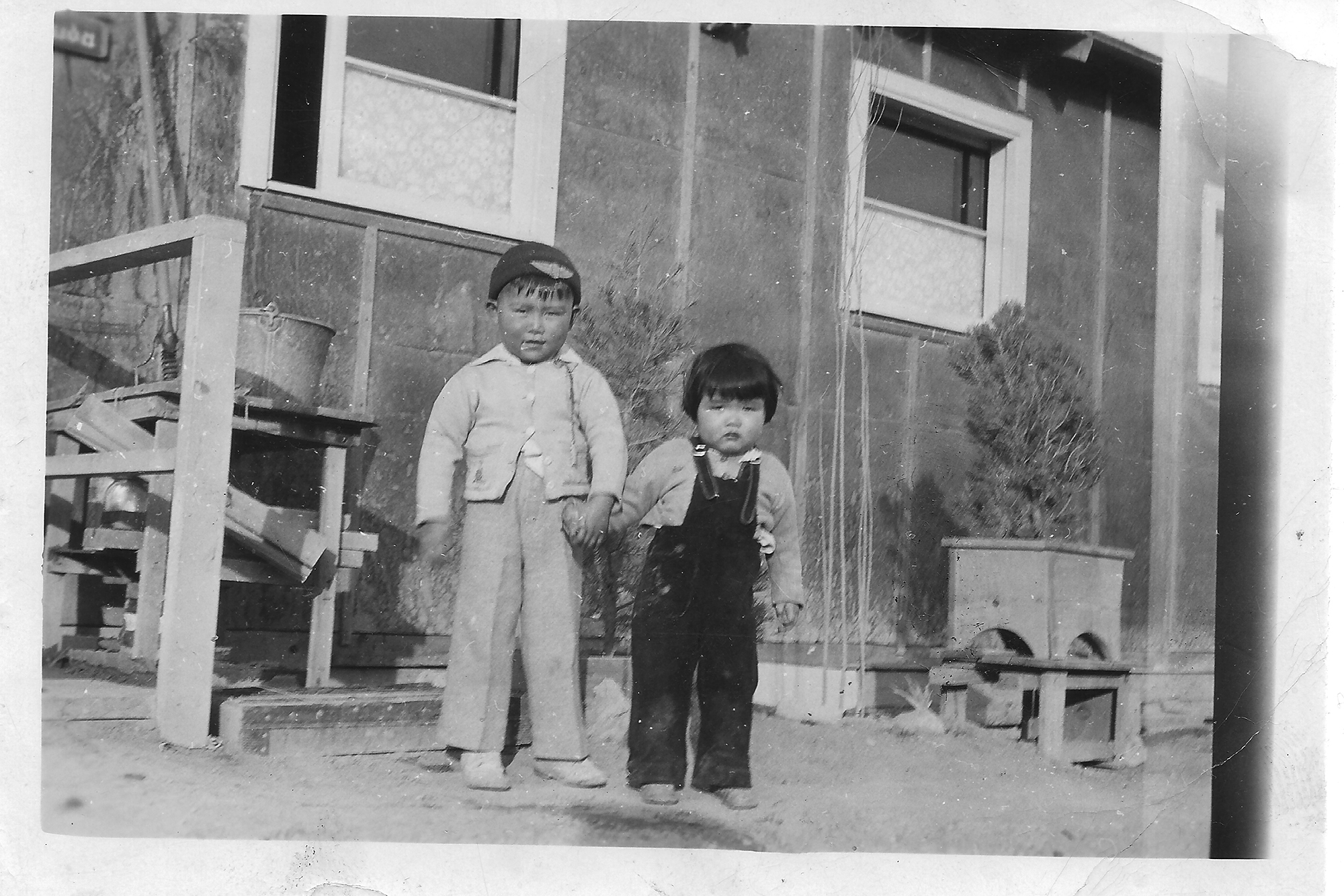“I would never describe her as not emotional, but she doesn’t cry. I don’t think she lets herself feel that stuff. I think she lets herself feel anger and anxiety—but not sadness.”
— Kimiko Marr, on her mother

Patricia Michiko Masuda
Sansei
Patricia Michiko Masuda was born in San Jose and grew up in the Bay Area. She was a few days shy of her second birthday when she and her family were sent to Topaz after being detained at Tanforan Assembly Center. She is the younger sister of Ronald Isao Masuda.
Although Patricia does not recall much of her incarceration due to her young age, she remembers “Camp Santa” visiting the camp during the holidays. “The one memory that she always shares is that she and my aunt got scared of Camp Santa and they hid under the mess hall table,” says her daughter Kimiko. “It was really creepy. You have these Nikkei men putting on this rubber mask of a white man and scaring the kids.”
In the summer of 1944, Ronald’s father applied for the Citizen’s Indefinite Leave Card as part of the resettlement program to work for a jeweler in Cleveland, OH. When the rest of his family was released, they headed westward to settle back in California. They worked as sharecroppers while living in a tent on their employer’s property. They later moved into a house with their extended family until Patricia’s father was able to save enough money to buy property and build a house a few years later.
In 2017, Patricia joined her daughter Kimiko on a pilgrimage to Topaz. While walking around the former concentration camp brought Kimiko to tears, Patricia had a more subdued reaction. “I would never describe [my mom] as not emotional, but she doesn’t cry,” Kimiko says. “I don’t think she lets herself feel that stuff. I think she lets herself feel anger and anxiety—but not sadness.”

Patricia’s information as it appears in the Final Accountability Roster for Topaz. Courtesy of Densho Encyclopedia.

The Masuda family stands for a portrait at Topaz. Clockwise from top left: Patricia’s mother Yoneko, Patricia’s father Kazuto, Patricia’s sister Eileen, Patricia and Patricia’s brother Ronald. Courtesy of the Marr Family Collection.

Listen to this portrait.
Kimiko Marr
Yonsei
Kimiko Marr was born in Hayward, CA and is the daughter of Patricia Michiko Masuda. Growing up, she says she did not feel particularly connected to the Japanese American community until she attended her first pilgrimage in 2016. “I lived amongst white people, but I always knew that I wasn’t going to ‘pass’, so I was always aware of race,” she says.
One thing that made Kimiko definitively Japanese was her name. “It was my white dad that wanted me to have a Japanese name,” Kimiko says. “Nichole, my middle name was what my mother wanted to name me. But my dad wanted me to have that connection with Japanese culture.”
The decision did not come without consequence. “First day of school, every year, you knew when they got to my name because there’d be this long pause,” she says. “Nobody could pronounce it.” Kimiko briefly decided to go by Kim in high school, but she changed her name back to Kimiko in college. “I still hate my name. I hate saying my name. I hate hearing my name. It’s that deep,” she says. “But I got to the point, when I was probably in my mid-20s, where I was adult enough to be like, goddammit, this is my name. […] This is what my family picked out. Sorry if you can’t pronounce it, but that’s not my problem.”
In 2016, Kimiko attended her first pilgrimage at Minidoka. For the first time in her life, she felt a sense of belonging. “Everybody here is like me, looks like me, looks like an auntie or an uncle,” she says. “I can talk to them and instantly have some sort of rapport because we have similar stories.”
The following year, Kimiko invited her mother to make a pilgrimage to Topaz. When Kimiko took a walk around the site to photograph her grandfather’s keepsake—his Citizen’s Indefinite Leave Card—she grew emotional. “I just started bawling. It just bubbled up out of nowhere,” she says. “I was thinking about my grandparents and thinking about them being there—how hard that must have been.”
One of Kimiko’s regrets is that she did not ask her grandparents many questions about their incarceration. “It was never a hidden thing. […] I don’t remember a time that I didn’t know. They never hid it,” she says. “I just never, never asked. Always a big regret.”
Kimiko is the Executive Director of Japanese American Memorial Pilgrimages, a non-profit organization that hosts and facilitates annual pilgrimages to the former camps. She is also the Chair of Tadaima! A Community Virtual Pilgrimage, a month-long virtual gathering and educational program serving the Nikkei diaspora.



